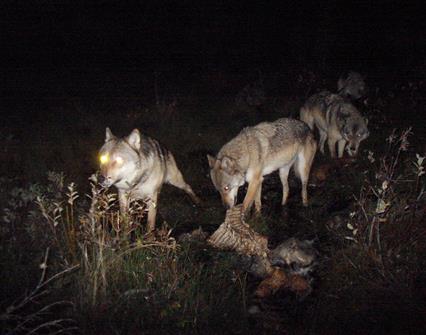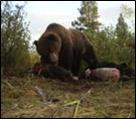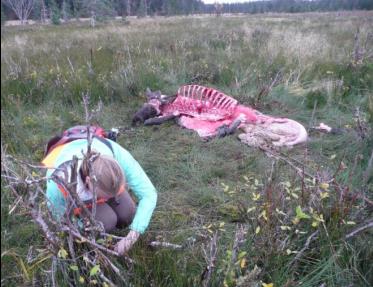How do the diets of two large predators in Gustavus — wolves and bears — compare?
Project Dates
May 2010 - August 2012
Did You Know?
Brown bears have been around Glacier Bay since the time of John Muir; black bears probably arrived more recently. The two species co-exist in Gustavus and in much of the park, although black bears are less common in the upper bay and on the outer coast. Brown bears tend to dominate prime food resources such as salmon streams—black bears may adjust by becoming nocturnal or otherwise avoiding their larger cousins.
Introduction

Predation by large carnivores can have profound direct and indirect impacts on prey populations, ecological processes, and community dynamics. Variability in the quality and availability of food resources in turn affects the food habits of carnivores. Carnivore diet selection can also influence the interactions among carnivore species that compete for similar food resources. Knowledge about the diet of co-occurring and potentially competing large carnivores is key to understanding their concurrent resource use and resource needs.
The goal of this study was to evaluate large carnivore (wolf, black bear, and brown bear) food use in the Gustavus-Glacier Bay ecosystem. Specific objectives were to:
1. Identify the spring food habits of wolves and bears in the Gustavus-Glacier Bay ecosystem, and
2. Evaluate the extent of large carnivore use of human-provisioned moose carrion.
Methods

Field work was conducted in 2010 and 2011 (May-June and September-October). The
researcher and her assistants collected fresh scats, dissected the scats to identify food items, and quantified the frequency of occurrence of the different food items observed in scats. They also deployed motion-detector cameras at moose harvest sites and analyzed the resulting images to identify the carnivores and scavengers that use these high-quality resources.
The research team obtained representative samples of wolf and bear scats by conducting scat surveys at 50 randomly selected 900 m × 900 m grid cells; they also collected scat opportunistically. They were not able to distinguish between brown bear and black bear scat.
During the annual Gustavus moose hunt the researcher located the remains of hunter-killed moose by communicating with the Alaska Department of Fish and Game and with local hunters, and by following aggregations of scavenging birds. A GPS location of each carcass was recorded along with a description of the carrion and the harvest date. A motion-detecting digital camera was set up to monitor scavenger use of the carrion.
Findings

The researcher analyzed a total of 55 wolf scat samples and 411 bear scat samples collected over the two years of fieldwork; 29 food items were identified. Moose was observed in about 80% of wolf scats (compared to a 1994 study in Adams Inlet that found moose in only 3% of wolf scats); the next most common food item found was bird in about 10% of scats. Bear scats were dominated by vegetation: 80% of the samples contained sedges, while only 8% contained moose. Samples were collected prior to the onset of the berry and salmon spawning seasons.
During the fall of 2010 the remains of 12 harvested moose were located; 7 were located in 2011. A total of 9,874 images of 13 different species of wildlife were captured, as well as several images of domestic dogs. Not surprisingly, ravens and magpies were the most common scavenger photographed. The researchers are still analyzing data related to the timing of scavenger activity.
Learn More
ADF&G Website www.adfg.alaska.gov/ has a wealth of information on wildlife.
Last updated: September 13, 2016
